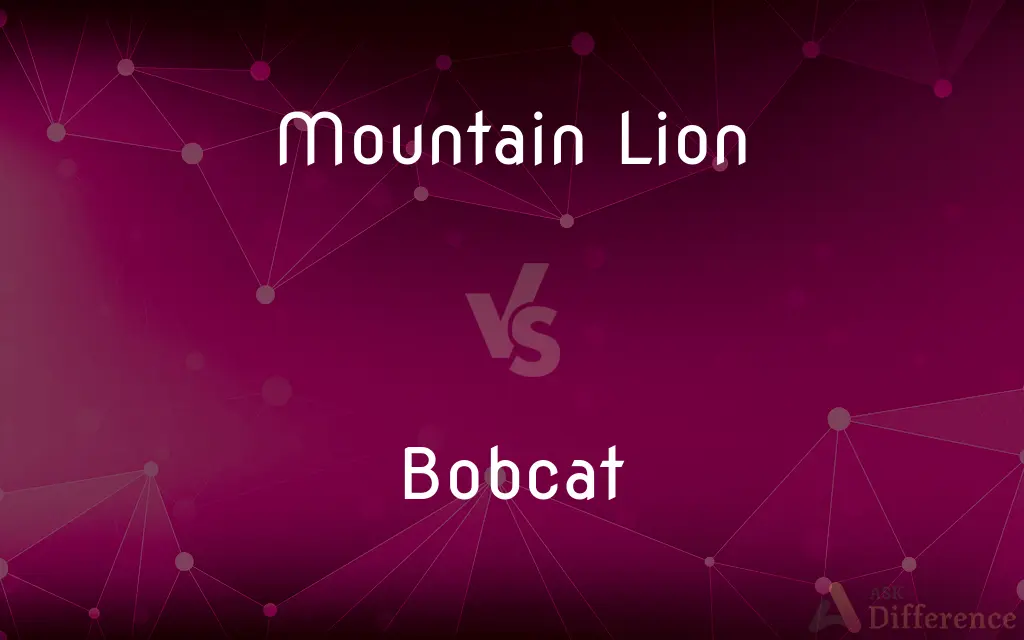Mountain Lion vs. Bobcat — What's the Difference?
By Tayyaba Rehman — Published on December 23, 2023
Mountain Lion is a large wild cat native to the Americas. Bobcat is a medium-sized wild cat found in North America. Mountain lions are larger and lack the bobbed tail characteristic of bobcats.

Difference Between Mountain Lion and Bobcat
Table of Contents
ADVERTISEMENT
Key Differences
The Mountain Lion and the Bobcat are both wild cats native to North America, but they differ in size, habitat, appearance, and behavior. Mountain Lions, also known as cougars or pumas, are much larger than Bobcats and are recognized for their slender bodies and long tails.
In terms of appearance, the Mountain Lion sports a uniform tan or light cinnamon coat with a white underside. Bobcats, on the other hand, exhibit a spotted coat and a short "bobbed" tail, which gives them their name. The face of the Bobcat also has distinctive tufts of hair on its ears.
Habitat preferences vary between the two as well. Mountain Lions cover a vast range stretching from the Canadian Yukon to the southern Andes of South America. They're versatile, residing in forests, mountains, and swamps. Conversely, Bobcats predominantly inhabit wooded areas, urban edges, and swampland across North America.
The behavior of a Mountain Lion is more solitary and secretive than that of a Bobcat. While both are carnivorous predators, their choice of prey differs. Mountain Lions often hunt larger animals like deer, while Bobcats focus on smaller prey like rabbits, birds, and rodents.
Despite their differences, both the Mountain Lion and the Bobcat have had to adapt to the changing landscapes of North America due to human encroachment. Both species showcase the adaptability and resilience of the continent's wild cats.
ADVERTISEMENT
Comparison Chart
Size
Larger, up to 220 pounds.
Medium-sized, up to 30 pounds.
Appearance
Uniform tan coat, long tail.
Spotted coat, short "bobbed" tail.
Range/Habitat
From Canada to South America; diverse habitats.
Mainly North America; wooded areas, urban edges.
Prey
Larger animals like deer.
Smaller prey like rabbits and birds.
Physical Characteristics
Lack of ear tufts, round face.
Distinctive ear tufts, more angular face.
Compare with Definitions
Mountain Lion
Also known as a cougar or puma.
The Mountain Lion has several regional names.
Bobcat
Native to North America with a spotted coat.
The Bobcat's spotted coat helps it blend into its surroundings.
Mountain Lion
Solitary and highly adaptable predator.
Despite human expansion, the Mountain Lion has adapted to various habitats.
Bobcat
Known for its distinctive tufted ears.
You can recognize a Bobcat by the tufts on its ears.
Mountain Lion
A large wild cat native to the Americas.
I spotted a Mountain Lion while hiking in the Rockies.
Bobcat
Medium-sized wild cat with a bobbed tail.
A Bobcat was seen prowling near the campsite.
Mountain Lion
Recognized by its tan coat and long tail.
The long tail distinguishes the Mountain Lion from other wild cats.
Bobcat
Predominantly nocturnal and elusive.
The Bobcat is often active during dawn and dusk.
Mountain Lion
Apex predator with a broad territorial range.
The Mountain Lion's territory can span over 100 miles.
Bobcat
Carnivorous predator, often hunting small prey.
A Bobcat primarily preys on rabbits and rodents.
Bobcat
A wild cat (Lynx rufus) of North America, having spotted reddish-brown fur, tufted ears, and a short tail. Also called bay lynx.
Bobcat
A North American wildcat, Lynx rufus, having tufted ears and a short tail.
Bobcat
A multi-purpose construction vehicle, akin to a smaller version of a front-end loader or a backhoe (backhoe loader), with a one-man caged control cabin.
Bobcat
Small lynx (Lynx rufus) of North America.
Bobcat
Small lynx of North America
Common Curiosities
Is the Mountain Lion bigger than the Bobcat?
Yes, Mountain Lions are considerably larger than Bobcats.
Are Bobcats common in North America?
Yes, Bobcats are native to North America and are found in various habitats.
Where can you find a Mountain Lion in the wild?
Mountain Lions inhabit a range from Canada to South America, in diverse habitats.
Is the Bobcat's tail shorter than the Mountain Lion's?
Yes, Bobcats have a distinct short "bobbed" tail.
Are Bobcats and Mountain Lions endangered?
While not endangered, both face threats due to habitat loss and human conflicts.
Which cat is more solitary: Mountain Lion or Bobcat?
Both are solitary, but Mountain Lions are especially secretive.
Which animal preys on larger animals, the Mountain Lion or the Bobcat?
The Mountain Lion typically hunts larger animals like deer.
What is a notable feature on the Bobcat's face?
The Bobcat has tufts of hair on its ears.
Do Bobcats have spotted coats?
Yes, Bobcats have a distinctive spotted coat.
What's another name for the Mountain Lion?
The Mountain Lion is also known as a cougar or puma.
Do Bobcats prefer a specific time for hunting?
Bobcats are predominantly nocturnal, often active during dawn and dusk.
What's the primary prey of the Bobcat?
Bobcats often hunt smaller prey like rabbits and rodents.
Can Mountain Lions and Bobcats coexist in the same habitat?
Yes, they can coexist, but they usually occupy different ecological niches.
Which is more likely to be seen in urban areas, the Mountain Lion or the Bobcat?
Bobcats are more commonly spotted near urban edges than Mountain Lions.
Are Mountain Lions known by any other regional names?
Yes, aside from cougar or puma, they're also called panthers in some regions.
Share Your Discovery

Previous Comparison
Beach Tent vs. Camp Tent
Next Comparison
L Isomers vs. D IsomersAuthor Spotlight
Written by
Tayyaba RehmanTayyaba Rehman is a distinguished writer, currently serving as a primary contributor to askdifference.com. As a researcher in semantics and etymology, Tayyaba's passion for the complexity of languages and their distinctions has found a perfect home on the platform. Tayyaba delves into the intricacies of language, distinguishing between commonly confused words and phrases, thereby providing clarity for readers worldwide.
















































